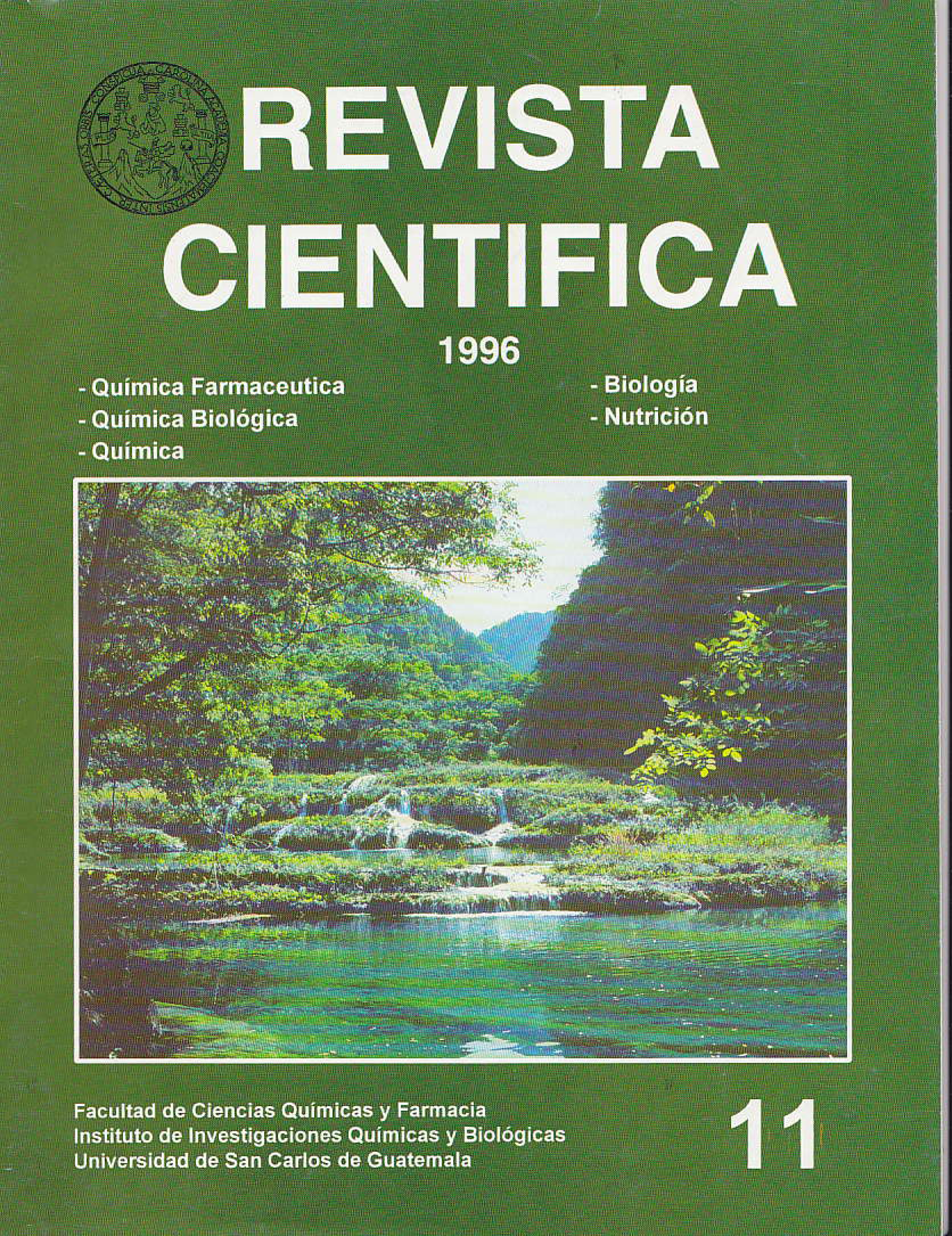Utilización del hueso de pollo para la inmovilización de enzimas: I. Inmovilización de papaína
DOI:
https://doi.org/10.54495/Rev.Cientifica.v11i1.371Palabras clave:
utilización, hueso de pollo, la inmovilización de enzimas, inmovilización de papaínaResumen
El hueso de pollo granular es un material que permite la inmovilización de enzimas por adsorción. En el presente estudio se pretendía ensayar la utilización del hueso de pollo para la inmovilización de papaína. Se produjo localmente, a pequeña escala, huso de pollo granular a partir de hueso de pollo crudo; un Kg. de este rindió 109 gr. de material seco de distintos tamaños de partículas (mesh 12-60) y un costo de producción de aproximadamente Q.200.00/Kg. El hueso de pollo con partículas mesh 14-20 fue ensayado para determinar su capacidad y eficiencia como soporte para la inmovilización de papaína. Este mostró una capacidad de inmovilización de 10.84 ± 0.36 mg de papaína/gr. peso seco (x ± n = 3), la papaína inmovilizada fue activa y exhibió el 26.9 ± 5 por ciento (x ± n = 3) de su actividad de enzima nativa. Las pruebas de estabilidad indicaran que la papaína inmovilizada sobre el hueso es reutilizable, conser vando en un segundo ensayo un 59-67 por ciento (n=3) de la actividad exhibida en el primero. Los resultados demostraron que sí es posible la producción local de hueso de pollo granular, y su utilización como material para la inmovilización de papaína.
Descargas
Citas
Gacesa P, Hubble J. Enzyme Technology. England-USA: Open University Press-Taylor and Francis, 1987, viii + 185p.
Brodelius P. Industrial Apliations of Immobilized Biocatalysts, pp. 75-129. In: Chose TK., Fiechter A., Blakebrough N. Advances in Biochemical Engineering. Vol 10. Heidelberg; Springer-Verlag, 1978. V1II + 1 77p, https://doi.org/10.1007/BFb0004472 DOI: https://doi.org/10.1007/BFb0004472
Uhling H. Enzyme arbeiten für uns: technische Enzyme und ihre Anwendrung. München: Hansa, 1991. VIII +436 S.
Messing RA. Carriers for Immobilized Biologically Active Systems, pp.51-73. In: Chose TK., Fiechter A., Blakebrough N. Advances in Biochemical Engineering. Vol 10. Heidelberg: Springer-Verlag, 1978. VIII + 177p, https://doi.org/10.1007/BFb0004471 DOI: https://doi.org/10.1007/BFb0004471
Schafhauser DY, Story KB. Co-immobilization of amyloglucosidase and pullulanase on to granular chicken bone for enhanced starch degradation. Biotechnol. Appl. Biochem., 1993;17:103-113.
Lowry OH, Rosebrough NJ, Farr AL, Randall RJ. Protein measurement with the folin phenol reagent. J. Biol. Chem., 1951:193-265-275, https://doi.org/10.1016/S0021-9258(19)52451-6 DOI: https://doi.org/10.1016/S0021-9258(19)52451-6
The United States Pharmacopeia 21th. Rev. Rockville, Md.: US Pharmacopeial Convention, Inc., 1984. Lvii +1 683p.
Hyndman D., Lever G., Burrell R., Flynn G. Protein Immobilization to alumina supports: I. Characterization of alumina-organophosphate ligand interactions and use in the attachment of papain. Biotechnol. Bioeng., 1992;40:1319-1327, https://doi.org/10.1002/bit.260401105 DOI: https://doi.org/10.1002/bit.260401105
Kuchel PW., et al. Bioquímica General. Ramírez MC., Cor tes DN., trads. Mexico: McGraw-Hill, 1994. xii + 698p.pp.l45.
Lehninger AL. Principles of Biochemistry. New York: Worth Publishers, 1986. viii + 101 1 p. pp.145, 158.
Peters T, Jr. Serum albumin, pp. 133-181 (p.147). In: Putnam FW, edit. The Plasma Protein; Structure, Function, and Genetic Control. 2 ed. New York: Academic Press, 1975. xvi+481p, https://doi.org/10.1016/B978-0-12-568401-9.50010-4 DOI: https://doi.org/10.1016/B978-0-12-568401-9.50010-4
Glazer AN., Smith EL. Papain and other sulfhydryl proteolytic enzymes, pp. 501 -545. In: Boyer PD, edit. The Enzymes Vol. III. New York: Academic Press, 1971, https://doi.org/10.1016/S1874-6047(08)60405-9 DOI: https://doi.org/10.1016/S1874-6047(08)60405-9
Wallerstein L : US-Patent 995.825 (1911).
Descargas
Publicado
Cómo citar
Número
Sección
Licencia
Derechos de autor 1996 Rubén D. Miranda Velásquez, Carmen G. Castillo Narvaez, Magda T. Flores López, Nancy E. López Estrada

Esta obra está bajo una licencia internacional Creative Commons Atribución 4.0.
Los autores/as que publiquen en esta revista aceptan las siguientes condiciones:
- Los autores/as conservan los derechos de autor y ceden a la revista el derecho de la primera publicación, con el trabajo registrado con la licencia de atribución de Creative Commons 4.0, que permite a terceros utilizar lo publicado siempre que mencionen la autoría del trabajo y a la primera publicación en esta revista.
- Los autores/as pueden realizar otros acuerdos contractuales independientes y adicionales para la distribución no exclusiva de la versión del artículo publicado en esta revista (p. ej., incluirlo en un repositorio institucional o publicarlo en un libro) siempre que indiquen claramente que el trabajo se publicó por primera vez en esta revista.
- Se permite y recomienda a los autores/as a compartir su trabajo en línea (por ejemplo: en repositorios institucionales o páginas web personales) antes y durante el proceso de envío del manuscrito, ya que puede conducir a intercambios productivos, a una mayor y más rápida citación del trabajo publicado.









